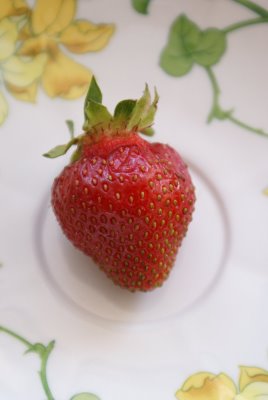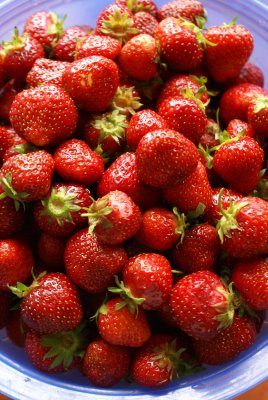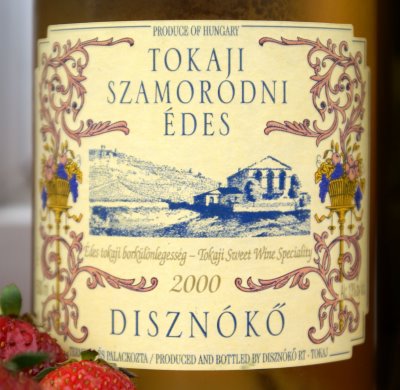The Return of the Queen
Posted on 14 July 2009

Poland is a strawberry empire, currently the 6th largest producer in the world and 2nd in the EU (after Spain). A large part of the production is processed into jam and other preserves and there’s a high chance your Bonne Maman confiture includes more than a fair share of Polish fruit.
But the major excitement is with the dessert strawberries. Starting with the second decade of May through about the current period in July you can buy fresh strawberries absolutely everywhere, from green markets to improvised stalls on the high street. They’re also ridiculously cheap (this year’s rate was 0.60€ / kg) and really, really delicious.
There are several factors that make Polish strawberries such a feat. They are predominantly grown by small and smallish farmers, avoiding the large-scale industrial conditions that they see in Spain (Poland and Spain together produce more than 60% of Europe’s crop). They are usually grown directly in the ground (industrial fruit is usually grown on plastic foilage or even more sophisticated devices such as high-trellised plastic tubes). I’ll be far from saying much of Polish strawberry is organically grown but they surely see less pest control and more rudimentary fertilisation than the mass-produced stuff. They’re also universally sold on the day of picking (or the morning after an evening harvest). Unlike Spanish or Chilean strawberries that keep for a week in the refrigerator, it’s best to eat them on the day.

Polish strawberries are usually moderate in sweetness and have quite a crisp taste, especially early in the season. I usually enjoy the very first weeks best: that semi-sweet, crisp, subdued flavour is very refreshing. The intensity and depth of flavour is unmatched by any strawberry I’ve tried in Europe. They’re almost finished for this year, but when you’re planning your June holidays next year, you now know where to come: to Poland for strawberry tourism!
It’s also interesting to look at strawberries as a companion to various wines. When you serve them with sugar and Chantilly or in a tart, you’re restricted to fairly sweet dessert wines, but eaten on their own in the glory of their unadulterated natural flavour, there’s a broader range of possible pairings. Here I opened four different wines to have a look at strawberries and wine matching.

Gunderloch Riesling Kabinett Jean-Baptiste 2006
This is a semi-sweet (almost semi-dry really), juicy, balanced, mineral Riesling from Germany. It’s low in alcohol and light on its feet, and finishes dryish-bitterish through its mineral charge (and perhaps a touch of noble rot / botrytis). With May strawberries, the sweetness level is just fine but the wine lacks a bit of flavour and presence. It’s more convincing towards the finish when the intensity grows, but there’s a clash between the fresh crisp fruitiness of the strawberry and the above-mentioned bitterish edge in the Riesling. In short I was a bit disappointed by this match. Perhaps better if the Riesling is younger and fruitier.
Adami Prosecco di Valdobbiadene Dry Vigneto Giardino 2006
A light, joyously frothy Italian fizz with a fair bit of residual sugar (‘dry’ is, in fact, a semi-sweet version). Notes of caster sugar and vanilla should be a natural match for strawberries. Yet the wine’s sweetness comes across as insufficient. Plus I’m not really convinced by the bubbles here: strawberries and fizz are an all-time classic for many people but for me, the slight coarseness and bitterness bubbles create on the palate tend to mask the natural fruit flavours. This was tried with not very sweet strawberries early in the season, and if you take sweeter fruit, it can be even more of a problem. It’s not a bad match all in all, but lacks sparkle to my tastes.
Tenuta Langasco Piemonte Brachetto 2007
This is a sparkling sweet red from Piedmont (similar to the Quagliano I reviewed

Disznókő Tokaji Szamorodni Édes 2000
A sweet Tokaj made of botrytised and overripe grapes harvested together, this is by far the sweetest wine in this flight (around 80g residual sugar I think). This older vintage is now showing in top form. Very typical nose of raisins, apricots, smoke and spice; fruit-driven on palate with moderate brown-sugar botrytis on end; finishes dryish and bitterish, inviting another glass. With strawberries, this is a good match if you follow the classic rule of serving a wine sweeter than its dessert. The delicate not-too-sweet strawberry flesh is slightly overpowered by the wine, plus there is no denying the contradiction between fresh fruit and botrytis that I observed in the Riesling above. Yet on a purely sensual level this works really quite well.
Conclusions? If you’re serving strawberries alongside biscuits or sponge cakes, a weighty sweet wine like the Tokaj I tried is a good all-rounder. For a luxurious apéritif, sweetish fizz is OK, provided it’s really fruity and intense. A Spätlese or light Auslese-styled Riesling is also a great idea, and this can be extended to other grapes such as Muscat or Pinot Gris. An intensely fruit semi-dry rosé could also work.

